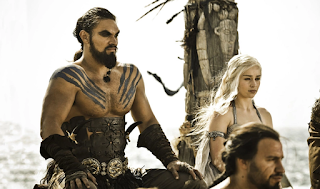Ulmo, taken after the Olympian Gods?
J.R.R Tolkien draws largely on the
legends and myths of Greek Gods and Goddesses to create his world of Arda,
particularly in regard to the deities of Arda who are called the Valar. It
seems as though Tolkien merely used the Gods and Goddesses of the Greek
into his world, tweaked them slightly, renamed them and then put them in his novel. This
borrowing of the cultures, legends, and myths from the Greek is clearly
illustrated in the character of Ulmo, Tolkien’s Water-God.
The Valar are one of the
aspects that give The Silmarillion its epic scope. They’re identical
to the Greek gods, sitting high atop Mt. Olympus which is a counterpart of
Tolkien’s Manwë ruling from atop mount Taniquetil. Zeus also has a brother,
Poseidon, who is the ruler of all waters on Earth and is second in power to
Zeus. Similarly, Manwë likewise has a brother Ulmo who rules all the
waters of Arda and is one of Manwë’s most trusted friends. There are also
physical similarities between Ulmo and Poseidon, such as they are both depicted
as having giant beards and carrying a trident in numerous fan art.
Some of Ulmo’s characteristics
can also be compared to the Greek God Apollo when he finds his oracle at Delphi.
After Apollo slayed the serpent known as Python who lives at Delphi,
Apollo is taking thought to who should occupy his temple when he sees a ship
sailing in the distance. Apollo transforms himself into a dolphin, and leads
the sailors to Delphi to be priests in his temple. At first the men despair at
the lack of farmland, but Apollo assures them that they will live well on the
gifts brought to the temple. This is a common theme seen where a God like
figure leads beings lesser than himself to a better life over the sea. It is
impossible not to see the parallels this has with Tolkien’s accounts of Ulmo
leading the elves, particularly the Noldor and the Vanyar, over the sea to Valinor
where they live in the presence of the Valar in bliss and comfort.
Ulmo also prefers to live
away from the rest of the Valar in Valinor and instead spends the majority of
his time wandering the many waters of Arda. Ulmo mostly meets often with the
Elves, who he loves and defends on their behalf in the council of the Valar.
Apollo has a similar liking for a magical people of his world, the Hyperboreans
(a mythical race of giants). Like Ulmo, Apollo spends little time among the
other Gods and Goddesses on Mount Olympus, rather he spends the majority of his
time at his Oracle in Delphi. When Apollo is not in Delphi, he spends three
months of every year among the Hyperboreans. The Hyperboreans also had a hidden
home similar to Tolkien’s description of Tol Eressëa. The descriptions of these
mythical people show that they are a source of inspiration for Tolkien’s Elves.
The Hyperboreans are portrayed as a magical people that are somewhat
more than human. Tolkien not only draws from the Hyperborean people when
creating his Elves, he also takes inspiration from their relationship with
Apollo to help create his Water-God character of Ulmo and his special
relationship with the Elves of Middle-earth and Tol Eressëa.






I love the detail here! How do you think Ulmo as Poseidon factors into, say, Helen Young's book? Is Tolkien's fashioning of the Valar part of a white tradition of hearkening back to Greek mythology? What do you think?
ReplyDelete